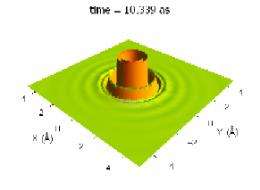Ultrafast imaging of electron waves in graphene (w/ Video)

The fastest "movies" ever made of electron motion have been captured by researchers using the U.S. Department of Energy’s Advanced Photon Source (APS) at Argonne and the Frederick Seitz Materials Research Laboratory at the University of Illinois at Urbana-Champaign (UIUC). The movies, which were created by scattering x-rays off of graphene, show that the interaction among graphene’s electrons is surprisingly weak.
Using inelastic x-ray scattering experiments at the X-ray Science Division 9-ID x-ray beamline at the APS, physicists from UIUC imaged the motion of electrons in graphene with resolutions of 0.533 Å and 10.3 attoseconds. Their results were published in the November 5 issue of Science.
Exactly how small and how fast are these measurements? An angstrom is 1/10,000,000,000 of a meter, about the width of a hydrogen atom. And an attosecond is to a second as a second is to the age of the Universe.
The 2010 Nobel Prize for Physics was awarded to Andre Geim and Konstantin Novoselov for their work on graphene, a single-atom-thick sheet of carbon atoms arrayed in a honeycomb pattern that exhibits many intriguing properties, including great strength, flexibility, excellent electrical conductivity, and heat resistance. As a result, graphene is a candidate material for a wide range of applications, including a new generation of low-cost, flexible electronics. A major outstanding question about this material is whether the electrons in graphene move independently, or if their motion is correlated by Coulomb repulsion.
The researchers in this study found that graphene screens Coulomb interactions surprisingly effectively, causing it to act like a simple, independent-electron semimetal. Their work explains several mysteries, including why freestanding graphene fails to become an insulator as predicted. The study also demonstrates a new approach to studying ultrafast dynamics, creating a new window on the most fundamental properties of materials.
More information: James P. Reed, et al. “The Effective Fine-Structure Constant of Freestanding Graphene Measured in Graphite,” Science 330(6005), 805 (5 November 2010). DOI:10.1126/science.1190920
Provided by Argonne National Laboratory

















